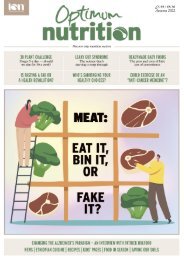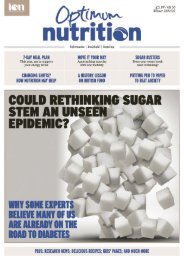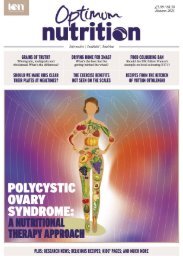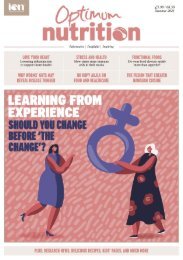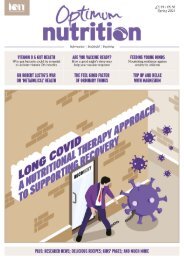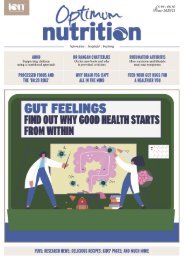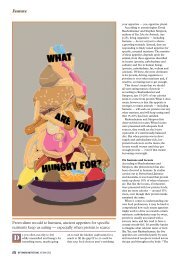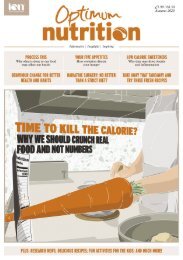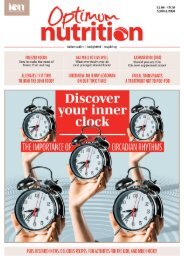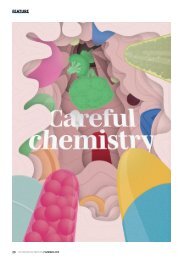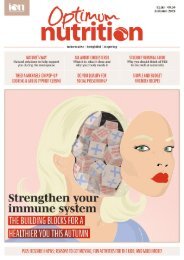Optimum Nutrition - Winter 2019/20 PREVIEW
Microbiome 101: you have heard of it, but what is it and what does it do? | Happiness on a plate: how to eat well to feel well this 2020 and beyond | Alice Herbst, Sweden’s Next Top Model 2012, now artist, talks about body dysmorphia and recovery | The benefits of cold water swimming and how to go about it safely | Which meat alternatives are best for you this Veganuary? | The power of gratitude for mental health | Plus kids' pages, recipes from ION graduate Amelia Freer Nutrition's latest book, Simply Good For You and more!
Microbiome 101: you have heard of it, but what is it and what does it do? | Happiness on a plate: how to eat well to feel well this 2020 and beyond | Alice Herbst, Sweden’s Next Top Model 2012, now artist, talks about body dysmorphia and recovery | The benefits of cold water swimming and how to go about it safely | Which meat alternatives are best for you this Veganuary? | The power of gratitude for mental health | Plus kids' pages, recipes from ION graduate Amelia Freer Nutrition's latest book, Simply Good For You and more!
You also want an ePaper? Increase the reach of your titles
YUMPU automatically turns print PDFs into web optimized ePapers that Google loves.
THIS ISSUE<br />
12<br />
Kick those winter blues to the kerb by eating well to feel well<br />
Sally Parr looks at how diet and lifestyle can help to perk us up at this gloomy time of year<br />
08<br />
30<br />
What lies within?<br />
The discovery of the microbiome has<br />
changed how many of us think about our<br />
health, but how much do we really know<br />
about what lies within? James Billot writes<br />
22 Interview<br />
In <strong>20</strong>12, Alice Herbst won Sweden’s Next<br />
Top Model. Today, she is working as an<br />
artist. She spoke to Louise Wates about<br />
body dysmorphia and recovery<br />
On your plate<br />
Start off <strong>20</strong><strong>20</strong> deliciously with these<br />
nutritious and tasty recipes from<br />
nutritional therapist Amelia Freer’s new<br />
book Simply Good For You<br />
44 Food fact file<br />
As many people will be trying out<br />
vegetarianism or veganism throughout<br />
January, we review some of the more<br />
popular protein alternatives<br />
Contents<br />
16 World cuisine<br />
Aran Goyoaga, pastry chef and food<br />
blogger, tells us about food from the<br />
Basque region, and shares a recipe from<br />
her new book<br />
25<br />
Little lives<br />
If telling your child about the health<br />
benefits of veg does little or nothing to<br />
engage their enthusiasm, it may be time<br />
to learn from the fast food industry<br />
34 Different strokes<br />
When it comes to feeling happy, actively<br />
choosing to be thankful for the little things<br />
in life can help. Ellie Smith looks at the<br />
power of gratitude<br />
18<br />
48 Move it 50<br />
Have you ever wondered why people<br />
swim in London’s freezing cold Serpentine<br />
in the winter? Alice Ball did, before going<br />
on to dip in more than a couple of toes<br />
40<br />
All about<br />
From the common cold to sepsis, we find<br />
out how the health benefits of vitamin C<br />
are being investigated for mild and critical<br />
diseases<br />
28<br />
Little lives<br />
After Catherine Morgan’s son showed off<br />
his bendy yoga moves, she asked what the<br />
benefits of this ancient practice might be<br />
for young bodies and minds<br />
Research update<br />
If January finds you thinking about diets<br />
and feeling the lack of sunshine, read our<br />
round-up of research on weight-loss and<br />
on the essential ‘sunshine’ vitamin<br />
Graduate story<br />
Lily Soutter on why studying at ION after<br />
completing a BSc in Food and Human<br />
<strong>Nutrition</strong> gave her the skills to start up a<br />
thriving business in clinical practice<br />
04 Comment / news | 26 Kids’ pages | 33 Book therapy<br />
36 Product news | 38 Kitchen chemistry | 39 In season<br />
WINTER <strong><strong>20</strong>19</strong>/<strong>20</strong> | OPTIMUM NUTRITION<br />
3
FEATURE<br />
12 OPTIMUM NUTRITION | WINTER <strong><strong>20</strong>19</strong>/<strong>20</strong>
FEATURE<br />
I<br />
f the depths of winter have left<br />
you feeling low, you are not<br />
alone. Last year, NHS Digital<br />
figures revealed that an estimated one in<br />
six people in the UK experiences common<br />
mental health problems during an average<br />
week.<br />
Symptoms can differ from person to<br />
person, ranging from what may just feel<br />
like the winter blues all the way through<br />
to an inability to function on a daily basis.<br />
Whatever the symptoms, it is important to<br />
tackle them or seek help, rather than just<br />
hoping they’ll go away.<br />
Looking to nutrition and lifestyle is a<br />
great place to start, but it’s important<br />
to discuss the risks and benefits with a<br />
registered nutritional therapist or your<br />
GP, and never stop taking prescribed<br />
medication without consulting your GP.<br />
Here are some smart strategies to get you<br />
started:<br />
Eat for gut health<br />
Diverse gut bacteria has been linked<br />
positively to mental health, with several<br />
types of ‘good’ bacteria thought to interact<br />
with the nervous system and play a key<br />
role in mood management. Some microbes<br />
even help with production of dopamine, 1<br />
the so-called ‘happy hormone‘.<br />
Probiotic foods, which are generally<br />
fermented foods such as live yoghurt,<br />
provide beneficial bacteria that can help<br />
support digestive health and regulate the<br />
immune system. Some studies have also<br />
found them to be useful in tackling anxiety. 2<br />
Scientists call these “psychobiotics” —<br />
probiotics that can be used to positively<br />
impact mental health by altering the way<br />
the gut communicates with the brain.<br />
It’s thought that in depression, certain<br />
messages don’t get through from the gut<br />
to the brain. In one study, researchers who<br />
noted a correlation between imbalances<br />
in gut bacteria and disorders of the central<br />
nervous system found improved mental<br />
health in healthy volunteers who consumed<br />
probiotic yoghurt and supplements for six<br />
weeks. 3 However, whilst acknowledging<br />
that the study showed promise, the<br />
authors recommended that further studies<br />
into psychobiotics were needed to explore<br />
the findings further.<br />
Good sources of probiotics include dairy<br />
produce such as yoghurt with live cultures,<br />
buttermilk and kefir. The latter is thought<br />
to act as a transport system for other<br />
probiotics, as well as having antifungal,<br />
antibacterial and anti-inflammatory<br />
properties. 4 Other fermented foods that<br />
are a good source of probiotics include<br />
tempeh, natto and miso made from<br />
soya beans; sauerkraut and kimchi from<br />
cabbage; plus kombucha from tea. The<br />
fermentation process produces beneficial<br />
bacteria that enable nutrients to leach<br />
from the food structure, making them<br />
more easily absorbed when we consume<br />
them. Eating foods that are rich in fibre<br />
also helps to feed your beneficial bacteria,<br />
which is another reason to make sure you<br />
are including vegetables, fruit, legumes and<br />
wholegrains in your diet.<br />
Eat 10 a day<br />
Several studies have linked a colourful,<br />
varied diet that includes vegetables, fruit,<br />
wholegrains and omega-3 fatty acids<br />
with good mental health. The standard<br />
western diet, however, including highly–<br />
processed foods, low levels of vegetables<br />
and fruit, and high levels of omega-6 fatty<br />
acids, has been linked with low mental<br />
health. Because high levels of general<br />
inflammation are often seen among<br />
patients with depression, it’s also thought<br />
that the anti-inflammatory and antioxidant<br />
properties of a plant-rich diet can help to<br />
support mental wellbeing.<br />
SMASH it<br />
In one study, researchers set out to see<br />
whether a plant-rich, Mediterranean style<br />
diet could improve mental health. 5 Their<br />
hypothesis was that low levels of omega-3<br />
fatty acids, higher levels of systemic<br />
inflammation in the body and nutritionally<br />
poor diets were common features in poorer<br />
mental health. Participants were given<br />
food hampers, omega-3 supplements<br />
and cookery workshops, and were asked<br />
to include fruit, veg, legumes, seeds,<br />
nuts, olives, olive oil, wholegrains and<br />
fish in their diet, and to restrict red meat,<br />
processed foods and confectionery. The<br />
result was a direct correlation between<br />
better diet and improved mental health,<br />
which was still evident after six months.<br />
One of the best ways to increase dietary<br />
omega-3 levels is by eating oily fish, with<br />
the acronym SMASH (salmon, mackerel,<br />
anchovies, sardines and herring) as a<br />
helpful way to remember which varieties<br />
to eat. Seaweed (in sushi), spirulina (add<br />
to smoothies), flax, chia and hemp seeds<br />
(sprinkled over yoghurt for breakfast) as<br />
well as walnuts and edamame beans are<br />
good sources for non-meat eaters.<br />
On a cautionary note, however, anyone<br />
taking blood thinning medication should<br />
avoid taking omega-3 supplements. A<br />
pharmacist, GP or registered nutritional<br />
therapist can advise on contraindications<br />
with medication you may be taking.<br />
Vitamins and minerals<br />
B vitamins are essential for our mental<br />
health, particularly B12. Because B12 is<br />
only naturally available in animal products,<br />
vegans are at greater risk of being deficient<br />
and so should take in supplements and<br />
fortified foods.<br />
Zinc is also a nutrient that has produced<br />
interesting results. One study found that<br />
healthy young females given zinc plus<br />
multivitamin supplements 6 reported a<br />
greater reduction in depression scores<br />
than those who only took a multivitamin.<br />
This, it is thought, could be due to zinc’s<br />
role in regulating chemical messengers<br />
(neurotransmitters). However, this was a<br />
controlled study and supplements are not<br />
always recommended — the NHS advises<br />
that high levels of zinc reduce the amount<br />
of copper that the body can absorb, which<br />
can lead to anaemia and weakening of the<br />
bones.<br />
Before considering supplements, look<br />
to diet to provide what you need. Good<br />
sources of zinc include cashew nuts, dark<br />
chicken meat, legumes including chickpeas<br />
and lentils, seafood such as crab and<br />
lobster, wholegrains and meat (organic,<br />
grass-fed if possible). Another important<br />
‘feel good’ mineral is magnesium, which<br />
helps to support a healthy ‘sleep/wake’<br />
cycle and to regulate mood. 6 Dark green<br />
leafy veg, beans and peas, seeds, nuts and<br />
wholegrains are all good sources of this<br />
relaxation-inducing mineral.<br />
Vitamin D is also important for healthy<br />
brain function. 7 Sunlight is the best source<br />
but it can also be obtained through SMASH<br />
fish, some types of mushroom, egg yolks<br />
and some fortified foods.<br />
Serotonin<br />
Eating food rich in tryptophan can improve<br />
levels of serotonin — a neurotransmitter<br />
believed to be important for regulating<br />
mood — which, in turn, may help to<br />
regulate sleep, improve energy and mood.<br />
An essential amino acid, tryptophan has to<br />
come from diet because the human body<br />
cannot produce it. Sources include turkey,<br />
chicken, salmon, eggs, spinach, nuts, seeds<br />
and tofu.<br />
Exercise outdoors<br />
Physical activity can be just as effective<br />
as medication for some who suffer with<br />
depression, and recent studies have shown<br />
that it can even help prevent depression<br />
occurring in the first place. 8 For those<br />
already taking medication, exercise may<br />
also work as a ‘replacement’ second<br />
anti-depressant. One study, however,<br />
highlighted that activity does need to be<br />
personalised. 9<br />
Although it can be hard to feel motivated<br />
to be physically active when it’s blowing a<br />
gale outside, in winter, when the amount<br />
of light hitting the back of the eye is<br />
reduced, it is important to get as much<br />
WINTER <strong><strong>20</strong>19</strong>/<strong>20</strong> | OPTIMUM NUTRITION<br />
13
INTERVIEW<br />
Modelling in Los Angeles might seem like a dream job, but for Alice Herbst it only encouraged<br />
disordered eating. She talked to Louise Wates about how using social media as a teenager fed<br />
her anxiety and body dysmorphia, and how becoming a professional artist helped her to heal<br />
22 OPTIMUM NUTRITION | WINTER <strong><strong>20</strong>19</strong>/<strong>20</strong>
INTERVIEW<br />
W<br />
hen Alice Herbst won the <strong>20</strong>12<br />
Sweden’s Next Top Model, to all<br />
appearances she must have been<br />
living the dream. Yet only six months into<br />
her prize of a modelling contract in Los<br />
Angeles, she was back home in Sweden<br />
and on a very different path. Today she is<br />
an artist with an Instagram following of<br />
79.9k. Although modelling is behind her,<br />
themes of self-image creep into her work<br />
and she describes her paintings as “parts<br />
of stories that could be self-experienced or<br />
inspired by daily observations”.<br />
We meet at the launch of Boogie<br />
Wall, a gallery dedicated to representing<br />
international female artists. Herbst, who<br />
graduated from the Swedish art school<br />
Gerleborsskolan in <strong>20</strong>17, is in London<br />
to showcase her paintings but I want to<br />
find out about her experience with body<br />
dysmorphic disorder (BDD), a mental<br />
health condition which leads to anxiety<br />
over physical appearance. She kindly<br />
accepts this request and talks openly but<br />
thoughtfully.<br />
Herbst has spoken about her BDD<br />
before and about her concerns over social<br />
media and apps that appear to be driving<br />
mental health problems. The press release<br />
accompanying the Boogie Wall launch<br />
explains: “Alice heavily criticises modern<br />
apps like Facetune that are advertised<br />
to young women to make themselves<br />
look slimmer. ‘Today people are able to<br />
bring their Facetuned photos to a surgeon<br />
to transform their appearance to their<br />
internet persona for good,’ she says as<br />
she addresses the importance of open<br />
discussions and awareness of mental<br />
health and eating disorders.” Yet it seems<br />
ironic that somebody who had suffered<br />
with BDD would put themselves forward<br />
for a career in modelling, especially<br />
through reality TV in which contestants<br />
are judged and eliminated on a weekly<br />
basis.<br />
But by the time Herbst entered the<br />
competition, she had been considered<br />
well for a year and a half, having already<br />
undergone therapy. The roots of her BDD<br />
go back to when she was 13 and changing<br />
schools. Her father worked in shipping, she<br />
explains, and so the family would move for<br />
his work. Being the new kid on the block,<br />
she found it difficult to make new friends<br />
and found herself to be isolated from<br />
friendship groups. “I felt very insecure. It<br />
was different from the town I was living in<br />
before... I was so tired with adapting,” she<br />
says.<br />
For many, however, social media<br />
can provide a route to friendship that<br />
the classroom does not always offer.<br />
Although Herbst tried to make friends,<br />
she eventually started talking with people<br />
“I started to paint my own experiences and there was... very<br />
symbolic... food pieces everywhere in my paintings...”<br />
online. Then, because photos were<br />
prominent on the platform that she was<br />
using, she began uploading photos of<br />
herself — in what became a trigger for<br />
BDD. Herbst says she suddenly found that<br />
what she thought she looked like, how<br />
she felt, and what she saw in her photos<br />
didn’t match. “I started to despise my face,<br />
I started to see things I didn’t like, my eye<br />
was hanging down — I just saw ridiculous<br />
things but they really had an impact on<br />
me.<br />
“In the end I wanted to have surgery. I<br />
just compared myself to everyone around<br />
me and wanted to look like what was a<br />
local ideal in my school. The boys liked a<br />
certain look — they wanted [a girl] to have<br />
a fuller face and a curvy figure and I was<br />
the opposite of that.”<br />
Makeup and mirrors<br />
Herbst began spending more time in<br />
front of the mirror trying to change<br />
her appearance. “I just wanted to be<br />
appreciated, so I started with makeup to<br />
change things and started to wear hair<br />
extensions.” Like so many others, she also<br />
tinkered with her photos to make herself<br />
look better, which only fuelled the bullying<br />
that she already faced. People who knew<br />
her would comment anonymously that she<br />
looked nothing like her photos, making her<br />
feel worse about herself.<br />
Herbst says that “it was five years<br />
becoming more and more worse before it<br />
got better”. Eventually, her parents got her<br />
help with a psychiatrist.<br />
Having recovered from BDD, it may<br />
seem odd that Herbst might throw herself<br />
into a world where appearance matters.<br />
“I would never ever today say that anyone<br />
who suffers from BDD should go and<br />
apply for a show like [Next Top Model]<br />
even though I felt very strong at that time.”<br />
But modelling agencies had told her that<br />
she was very skinny and tall, and that she<br />
looked like a model. “I didn’t want to look<br />
like that, I wanted to have curves all my<br />
life and I wanted to have another facial<br />
structure,” she says. “The agencies, on the<br />
other hand, appreciated my look.”<br />
During therapy, she says that she had<br />
started to expose her fears and pretend<br />
to be more secure and confident than she<br />
felt. “And then I started to feel that way for<br />
real so when this show was announced,<br />
that it was going to be Next Top Model, my<br />
friends said that I should apply.”<br />
Winning the show and starting a<br />
modelling career, however, only became a<br />
trigger for disordered eating — something<br />
from which she had not suffered before —<br />
because of the pressure to become even<br />
thinner. “I was free from BDD because<br />
that’s one part of the self-image issue,<br />
then I just got the other one — anorexia.”<br />
This time, however, Herbst knew that<br />
something was wrong and quit modelling.<br />
Painting became an outlet for Herbst<br />
as she recovered. “I started to paint in<br />
watercolours when I was coming home<br />
from Los Angeles, actually as a therapeutic<br />
way to heal.” Initially, her work reflected<br />
her anxiety with food. “I was thinking<br />
about food and food only, and all the<br />
anxious feelings I had about that, so I<br />
started to paint my own experiences and<br />
there was... very symbolic… food pieces<br />
everywhere in my paintings.”<br />
She completed high school and applied<br />
to art college. “I didn’t think that I would<br />
pursue an artist’s career but I wanted to<br />
have just one year to do something that I<br />
really loved, and it was the one thing that<br />
really helped me. I could stop thinking<br />
about all the body issues with the painting.<br />
So I continued and it healed me more.”<br />
Counting calories<br />
She now has a much healthier relationship<br />
with food, eats what she wants, will<br />
have an occasional indulgence, but aims<br />
for healthy balance. She also no longer<br />
obsesses over calories, which she had<br />
started to do whilst modelling.<br />
“It was such a long time before I could<br />
stop thinking about the calories. It took<br />
two years before I could finally feel like<br />
I’m not seeing the calories, because when<br />
I was a model — actually this is the first<br />
time I would ever tell anyone this — I<br />
had in my phone this calculator and was<br />
adding on all the calories every day.” Her<br />
target was to eat no more than 1,<strong>20</strong>0<br />
calories. “And I felt very good when I got to<br />
600 only. So starvation mode,” she says.<br />
“Today I don’t want to count calories,<br />
I just know that if I feel healthy I want to<br />
have a body that I can walk with and I<br />
can work with, and feel I just want to be a<br />
healthy person. I want to go back to where<br />
I was before all the modelling, just eat and<br />
don’t think about that.”<br />
For others who might be suffering from<br />
BDD, Herbst urges them to find something<br />
else to focus on. “So many girls or boys are<br />
thinking ‘If I do this I will be healthier, I will<br />
feel better if I change my looks this way…’,”<br />
she says. “But if you switch your focus<br />
onto something else and try to make a goal<br />
out of that — it doesn’t need to be painting<br />
— a sport, anything that makes you feel<br />
WINTER <strong><strong>20</strong>19</strong>/<strong>20</strong> | OPTIMUM NUTRITION<br />
23
ON YOUR PLATE<br />
Fish<br />
provençale<br />
Serves: 4<br />
Amelia says:<br />
“Provençale sauce is a really versatile and<br />
fragrant sauce that can be used to liven up<br />
the most basic of meals from pasta, jacket<br />
potatoes, chicken or fish, as here. If you<br />
feel you need something more filling, add<br />
some wholegrain rice or pasta or a serving<br />
of courgetti.”<br />
Ingredients<br />
• 1 onion, peeled and diced<br />
• 1 clove of garlic, peeled and crushed<br />
• Olive oil<br />
• 1 x 400 g tin of cherry tomatoes<br />
• 70 g pitted black olives<br />
• 4 fish fillets, frozen or fresh<br />
• Fresh basil, torn, to finish<br />
Method<br />
This works best in a shallow frying pan<br />
with a lid, although a large cast-iron<br />
casserole dish with a lid can also be used.<br />
Sauté the onion and garlic together in<br />
a little olive oil for 8 to 10 mins, until soft.<br />
Add the cherry tomatoes and black olives<br />
and bring to a very gentle simmer.<br />
Top with the fish fillets and cover<br />
with the lid. Poach for 10 to <strong>20</strong> mins<br />
(depending on the size of the fish and if it<br />
is fresh or frozen. It is done when opaque<br />
all the way through and flakes easily).<br />
Serve hot, sprinkled with basil leaves.<br />
WINTER <strong><strong>20</strong>19</strong>/<strong>20</strong> | OPTIMUM NUTRITION<br />
31




